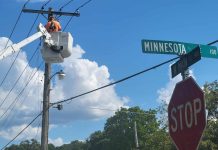ROLLA, Mo. (Jan 10, 2020) – The beautiful waterways that traverse Missouri are the lifeblood of Mark Twain National Forest (MTNF). The soils of the forest provide the arteries through which that water flows. Healthy forests depend on healthy soil and hydrology, and so do aquatic species. Forest Service personnel conducted several projects this past year that were beneficial to these valued ecological components.
One example in 2019 of MTNF improving habitat for aquatic species was the Barney Creek Streambank Restoration Project. As the name implies, this took place on Barney Creek, a Huzzah Creek headwater stream. Past land clearing and uses caused steep, eroding banks void of vegetation. The lack of plants led to increased soil erosion, eventual loss of land in the floodplain, and loss of aquatic habitat. The project on Barney Creek was a great example of using nature to help nature. An engineering technique using natural materials, such as trees and other large woody debris, was used to build structures at three sites with major bank erosion issues. This material creates the development of pools needed for aquatic habitat species, while deflecting the stream away from the eroding streambank. Planting of native riparian floodplain species will occur in Spring 2020. This project is the first streambank restoration project on the Mark Twain using large wood. Accomplished in partnership with The Nature Conservancy, the project utilized the expertise of the Forest Service Eastern Region Technical Services Team and local MTNF staff to reach fruition. This project will benefit many fish and mussels, including five federally-listed, endangered mussel species found downstream in the Meramec River.
Another project in the Huzzah Creek Watershed is the Brickey Slab Project. Huzzah Creek is a beautiful tributary that feeds into the Meramec River. In partnership with Crawford County through a Road Agreement, the MTNF awarded the contract for the replacement of the Brickey Slab Low Water Crossing to help improve aquatic organism passage in this waterway. The project will replace the current low water bridge structure, reconnect aquatic habitat, and improve public safety. Additionally Crawford County and MTNF entered into a Good Neighbor Agreement to work together to ensure completion of the Brickey Slab Low Water Crossing Replacement contract in FY 2020.
At the end of 2018, Mark Twain hosted the 2018 Central States Forest Soils Workshop, providing a training opportunity for 132 people from the across the Forest Service and partnering agencies, and included a large number of foresters in attendance. This set the stage for a productive year for MTNF Ecology and Soils Program in 2019, which focused on data collection to support the MTNF Terrestrial Ecological Unit Inventory project. NRCS chose the Ozarks as a priority for Digital Soil Mapping (DSM) development this past year. An MTNF employee led the Ozarks DSM Team, a multi-agency effort that includes Forest Service’s Northern Research Station and Geospatial Technology and Applications Center (GTAC). An NRCS Soil Survey Correlation Review with the Ozarks Soil Survey Office, Region 6 Regional Office out of West Virginia, and Missouri NRCS State Office was also conducted to ensure data accuracy and to begin analyzing collected data. NRCS provided a soil scientist to assist with four weeks of field work and provided laboratory analysis for over 400 soil samples.
Ecological-based inventory and mapping of MTNF and the surrounding areas of the Ozarks will benefit everyone involved in forest management. It will help decision makers understand the soil-types in every area of the Forest and make informed decisions about restoration goals and techniques with more accuracy than before.
Better restoration techniques means healthier soil; which means healthier trees and less erosion; which improves the condition of streams and rivers; and that leads back to improving conditions for our native aquatic species. This has a cascading effect, making for better fishing, and more opportunities for nature viewing of furbearers, amphibians, and birds whose survival depends on these riparian habitats.






